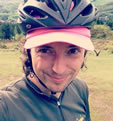"One of my colleagues is a cyclist too," the bearded brother is saying softly. "He'll make himself a sandwich at work and weigh the bread on kitchen scales."
I'm on the early morning train from Bruges, listening in to the conversation of three Scotsmen in the seats behind me. I spoke to them briefly as we got on the train, their bikes and cycle kit hinted they were heading my way. They are two brothers in their twenties and their father, from Edinburgh. The brothers work in London. They ride and race with Dulwich Paragon, but today - in Belgium for the Tour of Flanders - they are kitted out in their Edinburgh colours.
The cycling workmate anecdote continues:
"Then he'll cut some cheese and weigh that separately. He'll put the cheese on the bread, then he weighs the whole sandwich before he eats it."
There is a moment's silence while we each digest the extent of this fellow cyclist's obsession. Weighing it up against our own. "It sounds like he has an eating disorder," concludes the father finally.
If weighing your lunch is taking things too far, then where does travelling to Belgium to ride a sportive rank? Maybe not so crazy, when that sportive is the Ronde van Vlaanderen, or Tour of Flanders as we know it. Taking in the highlights of a hallowed Monument in cycling's Flemish heartland, it's a day I've been looking forward to over months of wintry Sussex training rides.
Simpson, Merckx and Boonen; Paterberg, Kwaremont, Koppenberg: the hills and heroes of Flanders reverberate through cycling lore like the clatter of cleats on cobblestones. Since signing up to ride the sportive, which takes place the day before the pro race, I've devoured online articles, magazines, books and archive footage to get a sense of what I'm in for.
Now the day has arrived; I've made it to Bruges, coming over on the ferry with my soigneur for the weekend, who has taken the job in exchange for the promise of Belgian chocolates. It's all gone smoothly to this point, but as our train pulls into Kortrijk we hit a snag - our connection to Oudenaarde is already pulling out of the station, and the next train isn't for an hour.
I'm worried I'll miss the start - there are 16,000 participants in this sportive; will there be enough cobbles to go around? But the wait in Kortrijk isn't wasted. While the Scots nurse coffees and talk among themselves I take the chance to get some breakfast from the station café. Tucking into a baguette I see a sleek team bus parked outside the hotel opposite, emblazoned with the blue and yellow livery of Tinkoff-Saxo. A table has been set up and staff are busy filling dozens of bidons. As I watch them work, an elderly local approaches me and tries to strike up conversation. Language is no barrier, he simply reels off a list of cyclists' names. "Boonen... Van Avermaet... Sagan... Cancellara!" I nod and smile. "Wiggins!" I reply. He shakes his head and wanders off.
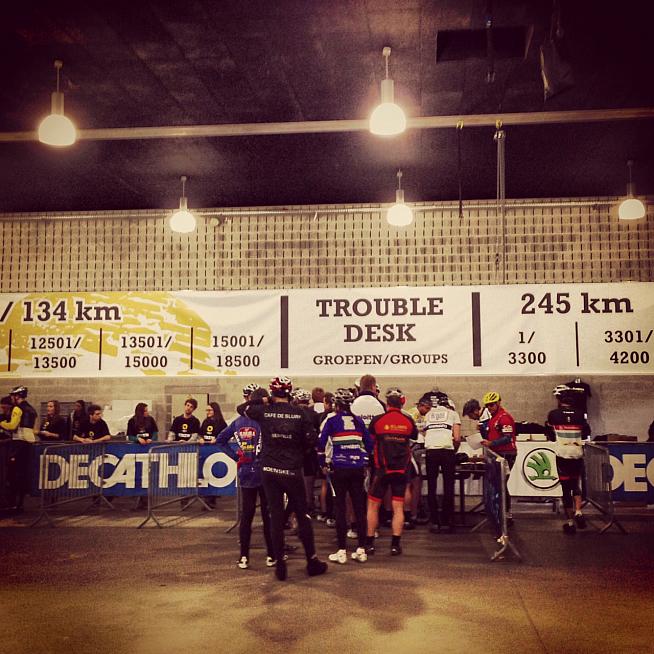
The train finally arrives, and 20 minutes later we're in Oudenaarde. It's now almost 10:00 am, but the start point is only a few minutes ride from the station. As the Edinburgh crew set off in a hurry I make for a desk named 'Trouble', where I mumble shamefaced that although I've signed up for the full 254km ride, I have since come to my senses - please, can I have a ticket for the 134km course instead? She hands me a spare number with a sympathetic smile, and that's it: I'm off...
The opening few km loop up one side of a canal, crossing it on a high bridge and then down the other side where it joins with the full route. Those riding the full distance have made their way down from Bruges - I saw some of them setting off a few hours earlier from the station, lights flickering in the dawn mist. I felt a pang of envy then, but hindsight suggests 80 miles is the right choice, as the medium course takes in all the 'fun' parts - the bergs and cobbles - and skips what is by all accounts a fairly tedious slog down the busy main road between Bruges and Oudenaarde.
As I soon find out, there's no time to get bored on the country roads around Oudenaarde. Just 10km in the first climb rears its head: the fearsome-sounding Wolvenberg. At 800m in length with an average gradient of 7.9% it's just enough to stretch the legs, but as it's tarmac rather than cobbles I'm halfway up before I realise I'm on one of THE notorious hellingen - hills - of Flanders. Cresting the top in 2 minutes, I wonder to myself. Is that really what all the 'Belgian hard men' fuss is about? This Flanders lark is going to be easier than I thought...
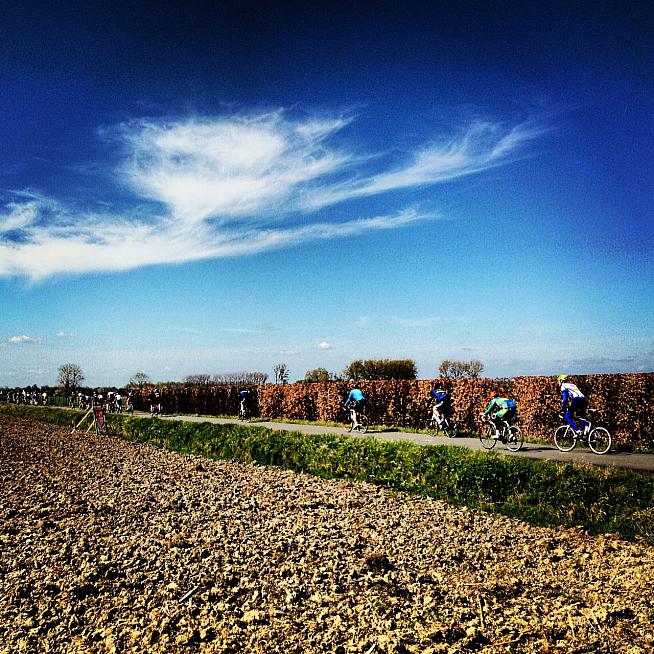
My complacency has barely had time to settle into its easy chair when I'm jolted awake by violent turbulence beneath my wheels, and a sensation of extreme vibrationary discomfort in my hands. And arms. And legs. And undercarriage. It feels like a sniper has shot out my tyres; I duck low on the bike and try to hurry on, my arms juddering uncontrollably and fingers flailing helplessly for the shifters. I've hit the cobbles, and all the horror stories were true.
Tim Krabbé, in his classic cycling book The Rider, jokes that Belgium's cobbled roads were 'built by the Romans, who just dumped a bunch of rocks out of a helicopter'. It's fair to say there is a certain agricultural quality to the pavé, but then again, these aren't urban streets. The narrow roads of the Ronde wind through farmland, and these rural roots have helped shape the character of the race. In some cases, literally: as I trundle along like a bowl of apples being bounced across the top of a washing machine on full spin, I'm reminded of an article in a recent issue of Cyclist magazine. The writer recounts that the 16% Paterberg is an artificial hill, created by a farmer who wanted a climb to rival the Koppenberg that was on his neighbour's land. A good idea, I thought at the time. I even considered piling a ramp of earth up to the roof of our suburban semi and inviting Mick Bennett over to consider it for next year's Tour of Britain. But only a pervert would pave their home-made hill in cobbles.
This is very unpleasant indeed, I think to myself as my bike appears to implode noisily beneath me. The chain is smacking off the stays at every jolt and a sickening medley of creaks and groans emanate from parts unknown. After the longest 800m of my life the Ruiterstraat kasseien (cobbles) come to a merciful end and I'm back on civilised road again. I give my poor bike a reassuring pat, but in my head I'm making funeral arrangements: she'll never survive this sportive.
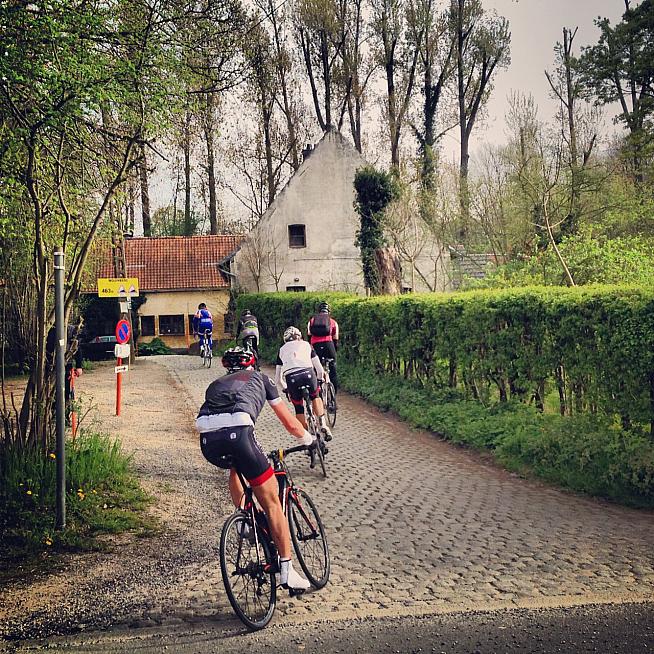
By the time the next stretch, Kerkgate, comes along a few minutes later I have formulated a cunning plan to save me and my bike from unnecessary suffering. As the cobbles begin I make a beeline for the narrow but relatively smooth concrete gutter along the side of the street, and stick to it. Sometimes parked cars mean I have to venture onto the cobbles, but where possible I hop onto the verge or back into the drains - anything to avoid the bone-rattling stones. I reach the end of the 2.6km section feeling guilty but vindicated, like a shipwrecked sailor who has had to eat his fellow crew to survive.
'And I'll do it again if I have to,' I vow grimly as I latch onto a passing train of unsuspecting fellow riders.
"Alright Brighton!" one of them greets me and my telltale jersey as I pull up alongside. It turns out he's come from Gloucestershire via Wimbledon, and just like Chaucer's pilgrim he has a Flanders tale to tell.
"My tyre shredded 10 minutes in," he explains, "totally ruined. So I pull over into the driveway of a house thinking that's it, my day's done.
"Then the guy who owns the house comes out and asks what's happened. Next thing I know he's driving me to a bike shop six miles away to get a new tyre!"
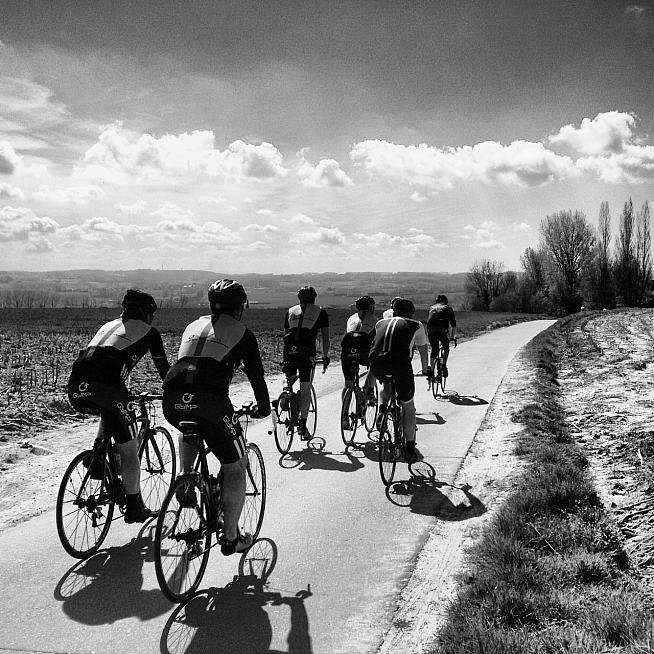
On we ride, the cockles of our hearts aglow at this example of Flandrian hospitality. And still the hills and the cobbles keep coming. Names laden with resonance like Molenberg, Koppenberg, and er... Karnemelkbeekstraat arrive and are conquered, each climb preceded by a handy sign setting out the name, length and gradient we are about to endure.
But the funny thing is that although these hills are steep, the roads are narrow and the cobbles are the snaggled teeth of Satan himself, I find myself actually looking forward to them. They give the ride a focal point, and weaving and bobbing up each short climb amid the encouraging cheers of roadside supporters is a surreal delight. On the Koppenberg I even find a burst of energy and a space ahead of me to pass the file of dismounted warriors wheeling their steeds to the top, only to be overtaken - the shame - by a chap piloting a bakefiets up the slope with a sickening air of nonchalance.
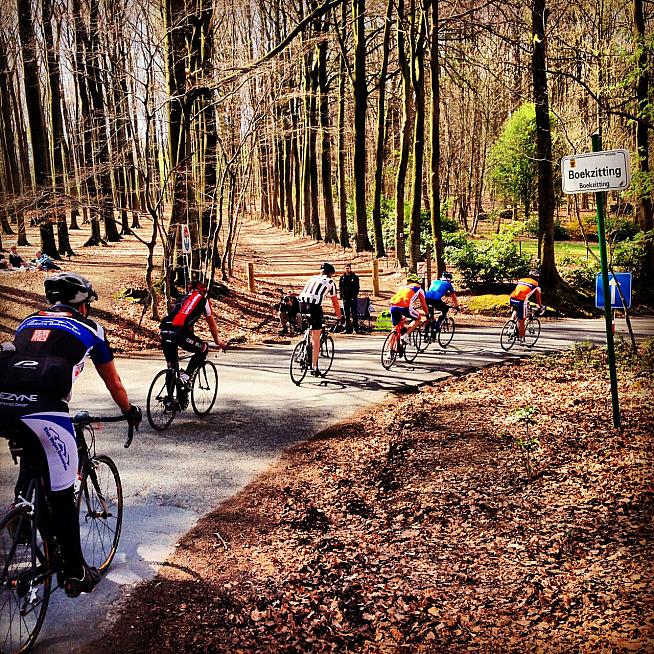
While negotiating a truce with the cobbles I am still taking every possible chance to dodge them. On the Eikenberg I discover that the locals, having come out in force to watch the sportive, don't take kindly to cyclists 'cheating' in the easy lane. As I'm halfway up the hill a gaggle of shirtless lads are leaning on the barriers, beer cans in hand, cheering on the knots of riders as they struggle past. Ahead of me a cyclist steers out of the gutter across the narrow road and high-fives the men as he rides. They cheer him raucously. As I approach, still firmly in the gutter, they wave me over and call out what sounds like 'koppeln!' I'm in no mood to oblige them with some bump'n grind on this gradient; I give them a cheerful nod and rumble on. Already they're hailing the riders behind me, like lairy sunburnt sirens luring sailors to a rocky end.
The 80 miles roll by in a happy albeit occasionally bumpy blur, with a few timely breaks to refuel on caramel waffles. The sun is out, it feels like a festival, but all too soon the last climb - the Paterberg - is upon us. With an average gradient of 12.9% it's not called "the daddy" for nothing, but a short sweat out of the saddle and it's all over in a few minutes, leaving a flat blast to the finish 10km away in Oudenaarde.
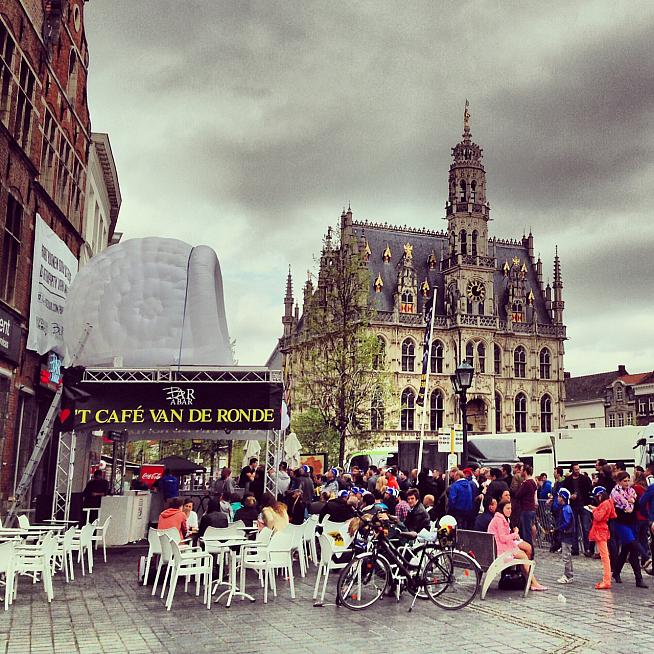
I get back to Bruges tired and triumphant to find my soigneur has been sunbathing and taking snapshots of the FDJ team, who have seemingly got lost in the town centre on a reconnaissance ride. The next day we'll drive down to Oudenaarde again to watch the pros tackle the race at warp speed, but for tonight it's off to sample some of Belgium's culinary traditions in the form of frites, steak and strong beer.
A week on, the pain of the cobbles is already receding; instead my Tour of Flanders memories are of the best weekend of cycling I've ever had. It doesn't matter if you don't follow pro cycling, or even if you don't like mayonnaise with your chips. The Ronde van Vlaanderen, at least on a sunny day, is a sportive experience like no other. If you like cycling at all, even just a little bit, get yourself over to Flanders next year and try it for yourself. You'll probably survive it; you'll never regret it.
Thanks to Golazo Sports for arranging our entry to the Ronde van Vlaanderen Cyclo, and to Kurt, our host in Bruges, for providing the perfect base to enjoy the sportive and the Tour of Flanders.
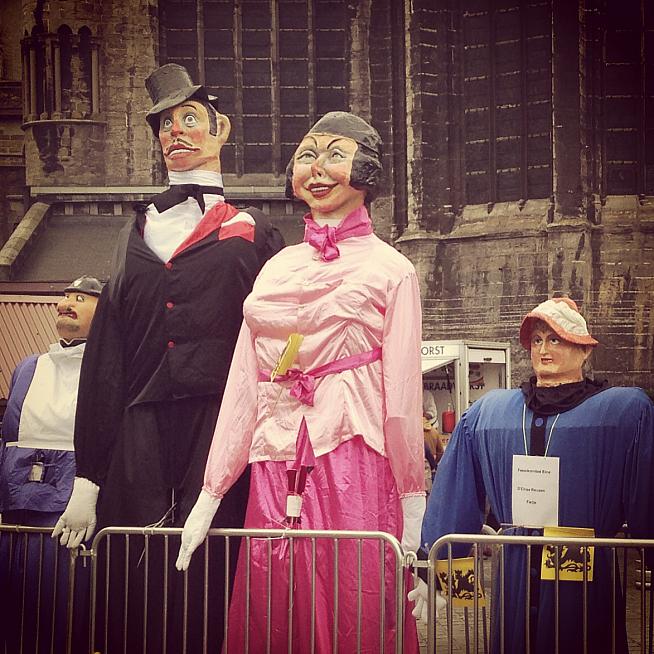
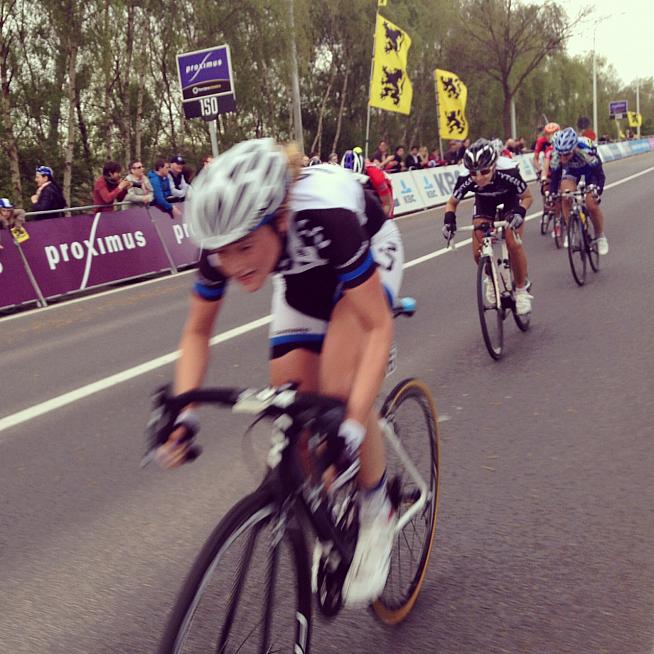
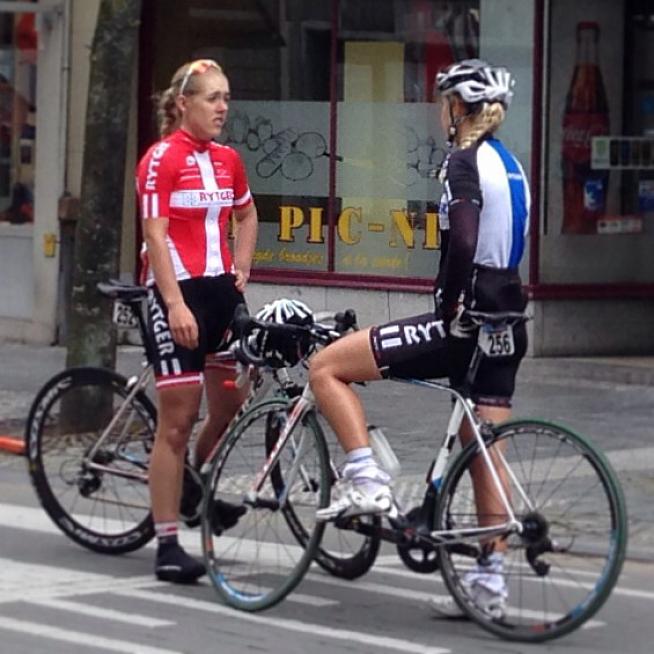
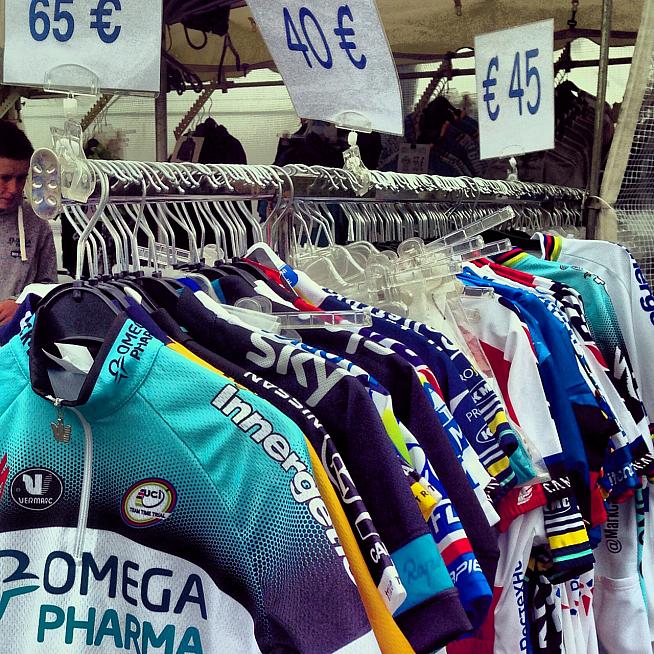
0 Comments

